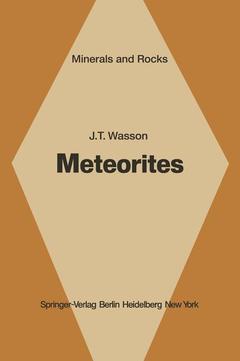I. Introduction: Meteorites as Probes of Processes Occurring Very Early in the History of the Solar System.- II. Classification of Meteorites.- A. Introduction.- B. Classification of Silicate-Rich Meteorites.- 1. Chondritic Meteorites.- 2. Differentiated Silicate-Rich Meteorites.- C. Classification of Metal-Rich Meteorites.- D. Summary.- III. The Study of Meteorites: Sources, Bibliographies, and History.- IV. Bulk Composition.- V. Mineralogy and Phase Composition.- A. General.- B. Pressure-Indicating Mineral Systems.- C. Temperature-Indicating Mineral Systems.- D. The System Fe-FeO-MgO-SiO2-O2 and Prior’s Rules.- E. The Fe-Ni System and Cooling Rates.- F. Other Mineral Systems.- VI. Petrology.- A. Petrographic Descriptions of Individual Meteorites.- B. Metallographic and Metallurgical Studies of Metal-Rich Meteorites.- C. Chondrules, Chondrite Petrology, and Metamorphism.- D. Calcium-Aluminium-Rich Inclusions.- E. Differentiated Silicate-Rich Meteorites.- F. Shock and Brecciation.- VII. Trace Elements.- A. Introduction: Mean Solar-System Abundances.- B. Partition between Coexisting Phases; Studies of Rare-Earth Elements.- C. Volatile Elements.- D. Refractory Elements.- E. Siderophilic Elements.- F. Miscellaneous Elements.- VIII. Stable Isotopes: Elements Other than Rare Gases.- IX. Stable Isotopes of the Rare-Gas Elements and Related Particle-Track Studies.- X. Primordial Radionuclides and Associated Chronologies.- A. Introduction.- B. Formation and Metamorphism Ages.- C. Formation Intervals.- XI. Breakup and Accretional History of Parent Bodies, Meteoroid Shape and Erosion, and Terrestrial Ages of Meteorites.- A. Cosmic-Ray Interactions.- B. Erosion and Preatmospheric Shapes.- C. Exposure-Age Distributions and Their Significance.- D. Accretional History.- E. Terrestrial Ages.- XII. Orbits.- XIII. Fall and Recovery.- XIV. Morphology and Macrostructure.- XV. Organic Matter.- XVI. Magnetic Properties.- XVII. Miscellaneous Physical Studies.- A. Density and Porosity.- B. Mechanical Properties.- C. Thermal Properties.- D. Electrical Properties.- E. Optical Properties.- XVIII. An Example of the Interpretation of Meteorite Properties: The Origin of Ordinary Chondrites.- A. Introduction.- B. Formation Ages and Intervals.- C. On the Number, Size, and Location of the Parent Bodies.- D. Evidence for Metamorphism.- E. Fractionation of Highly Volatile Elements.- F. Metamorphic Reheating.- 1. Temperatures.- 2. Heat Sources: Internal Versus External Heating.- 3. Internal Versus External Heat Sources.- G. Genomict Chondrites and Solar-Type Rare Gases.- H. Siderophilic-Element and Oxidation-State Fractionations.- I. Chondrule Formation.- J. Fractionation of Moderately Volatile Elements.- K. Fractionation of Refractory Elements.- L. Summary: Temperature History of the Nebula.- References.- Appendix I: Glossary.- Appendix II: Lists of Classified Meteorites.- A. Introduction: Alphabetical List of Well-Classified Meteorites.- B. Listing of Chondrites by Chemical Group and Petrologic Type.- C. Listing of Differentiated Silicate-Rich Meteorites by Chemical Group.- D. Listing of Differentiated Metal-Rich Meteorites by Chemical Group.



